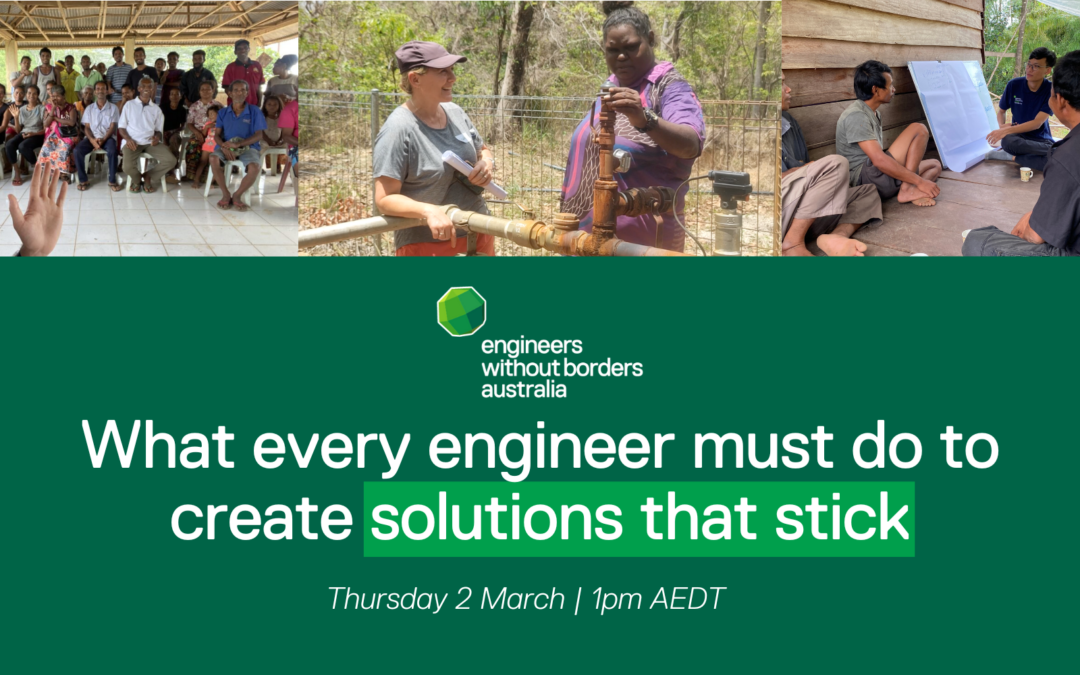Thank you to everyone who attended our webinar, What every engineer must do to create solutions that stick. We hope you enjoyed it as much as we did!
It was a wonderful discussion and we thank you for your insightful questions and feedback. In case you missed it, you can view the recording here.
As we ran out of time to answer all the questions submitted during the webinar, our panellist Leah Sertorio has provided answers to them below:
Q: Beyond drinking water, wondering how you go about communicating / campaigning for aspects of the water program that aren’t easily measurable in numbers? E.g. water as an enabler of culture; identity?
A: This is a really good question and is something I am still trying to determine how we ‘measure’ this as part of the program. If you have any insights from different environments/people would really be keen to hear and see how they might work to integrate in. I had an end slide in my presentation that I wanted to share in the webinar (see below). I would be keen to hear your thoughts around these and what you have seen/experienced might work well to embed within the water program?

Q: What water treatment processes do these communities usually require? and are there methods of water treatment that indigenous communities have learnt or used over the years that work best for them? This is a critical life source and I 100% believe that all people have the right to this resource
A: It really does depend on the water source. Typically, most remote areas are groundwater supplies and so as a supply system typically what is needed is a bore pump – usually solar (some cases I have seen windmill as well – all depends on power availability at the location etc) that feeds up to a water tank on a stand then gravity feeds to community. If the water is ‘good’ it may only need a disinfection process, if not then additional treatment steps may be needed e.g. aeration, filtration, and perhaps even reverse osmosis if the salinity is very high. At the end of the day however, the ‘technology’ is only one part of the puzzle – the most important part is the people! Building the relationship and listening to the mob so we can learn and understand cultural water value, experiences and sources – the resilience of the Aboriginal and Torres Strait Islander peoples over 60,000 years to understand how to look after water and where ‘good’ water is over different seasons and times is what needs to be embedded in how we then look to the sources, test these and determine if any treatment requirements may be needed.
It may be that not only one source is possible for resilience, and with the changes of use of land as well over the years, and climate change impacts. It may be that those sources identified by the mob are no longer viable and we have to find other sources which may need treatment – or their sources identified may need treatment anyways when we test it because of what we know now in Western science on the negative long-term impacts of different parameters eg uranium etc… and in that process we can then work with the mob to learn about the treatment system needed, how to operate it, what risks need to be managed, what asset plans need to be in place, what maintenance contracts might be needed and then how they can test to see if the water remains ‘good’ to drink and use for their purposes. I hope that answers your original question, and if not I am more than happy to chat more about this anytime.
Q: Have you heard of Project Gilghi – joint venture between Aurecon & Ampcontrol? https://www.aurecongroup.com/projects/water/project-gilghi
A: Hi there, yes I have – it is great to see the community able to have access to clean and safe drinking water. What I am not aware of though and would love to learn about more is what processes, community training and support mechanisms have been set up around this to ensure its sustainability and ownership by the community? I would love to know if the Community Water Planner approach was adopted in the setting up of the ongoing operation of the system. I understand there is an external contractor that comes to operate & maintain the system, however what happens if that contract falls over? Who is responsible for the ongoing operation of the system, and what roles & responsibilities do the different community members hold? Turnover of ‘staff’ is a big risk and so have community members been selected that have a long-term focus on being in community and are invested in ensuring the water system is operated and maintained. Have the community members been trained in how to operate the system and do basic maintenance, and have a process to follow for escalation of any issues that may occur? Does the community know what risks need to be managed, what asset plans need to be in place, ongoing maintenance contracts, and then the testing of the water – who does this, how, and when?
Lots of questions I am posing here! And I don’t know if this was completed as part of the project delivery for the long-term sustainability of the operation & maintenance of the system. If it all has, then this is fantastic news and I would really love to hear and see how the implementation process of this went as I would be very keen to talk this through with the team involved as would love to learn how this was implemented as I know there would be great learnings for the Engineering on Country water program. If there are any contacts you could share, I would really appreciate it!
Any further questions or comments, please feel to get in touch at info@ewb.org.au or speak to Leah directly at l.sertorio@ewb.org.au.


